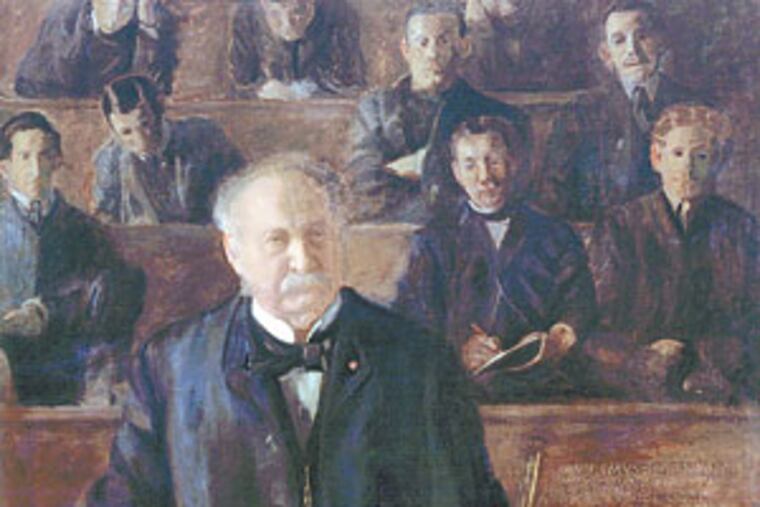Jefferson sells off its last Eakins
Thomas Jefferson University has sold the last of its three large paintings by Thomas Eakins, the Portrait of Professor William S. Forbes, a 1905 masterwork commissioned by the university community in honor of its great anatomy professor, surgeon and activist.

Thomas Jefferson University has sold the last of its three large paintings by Thomas Eakins, the
Portrait of Professor William S. Forbes
, a 1905 masterwork commissioned by the university community in honor of its great anatomy professor, surgeon and activist.
Jefferson officials declined to disclose the price paid for the painting or the name of the private buyer. The sale, consummated Wednesday, was brokered by Christie's auction house.
Officials of the Jefferson alumni association, who have opposed similar recent sales by the university, said Wednesday that they had not been informed a sale had been made.
In a brief statement issued to Jefferson employees late Tuesday, Jefferson board chairman Brian Harrison said that "a reproduction of the portrait will be placed in the University's Eakins Gallery" now that the painting has been dispatched.
That gallery once housed Eakins' masterpiece, The Gross Clinic, which the university sold late last year for $68 million to a partnership of the Philadelphia Museum of Art and the Pennsylvania Academy of the Fine Arts. The massive canvas is currently on view at the academy; the two institutions will share it.
The reproduction of The Gross Clinic, now in the Eakins Gallery in the 1000 block of Locust Street, has become known as "the Fakins," according to university staff.
Jefferson had initially planned to sell The Gross Clinic to a partnership of the National Gallery of Art in Washington and the unbuilt Crystal Bridges Museum of American Art in Bentonville, Ark., which is backed by Wal-Mart heiress Alice Walton.
Wide controversy ensued, however, sparking a successful regional effort to match the price - a record for both Eakins and all pre-World War II American paintings - and keep the painting in Philadelphia.
In April, Jefferson sold its portrait of Dr. Benjamin Rand, a chemistry professor who taught at Central High and the Franklin Institute before arriving at Jefferson Medical College.
On that occasion, Crystal Bridges succeeded in acquiring the painting, paying about $20 million.
In the meantime, the Pennsylvania Academy, faced with debt worries due to the Gross Clinic purchase, sold another Eakins canvas, The Cello Player, one of its four Eakins oils, for an estimated $15 million to $18 million. (Officials at the Art Museum are mulling a similar type of sale, but have made no decision, museum sources said recently.)
A second statement issued by the university Wednesday said proceeds from the Forbes sale "will be used to support the mission of the university and the implementation of its new strategic plan."
All of the paintings involved in the Eakins transactions had been on public view in Philadelphia for more than a century.
Kathleen Foster, curator of American art at the Art Museum, called the portrait of Forbes "a great painting" revealing Eakins' empathy for his subject, who was near the end of a long and difficult career.
Forbes is presented leaning on an operating table, a frail man in his 70s, one hand on a document labeled "The Anatomy Act," 19th-century legislation that legitimized acquisition of unclaimed cadavers for medical purposes.
Before its passage, doctors and educators had been compelled to deal with body snatchers; the act effectively ended widespread grave robbing.
Forbes fought for the legislation, which became a national model, and was himself arrested and charged with grave robbing in 1882. He was acquitted, with Jefferson faculty, including Gross, rallying in his support and to fund his defense.
But Forbes' trial received lurid publicity, and his political activism, despite its success, came at great personal cost.
"There's a fragility there," said Foster of the portrait. "He clearly does not look well, and he died not long after."
Eakins, she said, "could relate to Forbes because he had gone through great personal distress. He stuck to his principles the way Eakins did."
The Gross canvas is widely considered Eakins' greatest painting and depicts a revered Jefferson teacher, and the portrait of Rand has a lively informality to it. Both were painted in the 1870s and were only later donated to the university.
Gross was purchased by alumni and given to Jefferson in 1878; Rand donated his portrait in 1877.
But the university community specifically commissioned the Forbes portrait, which was paid for by contributions from alumni and students, and presented at Jefferson's 80th annual commencement in Forbes' honor at the end of his long career.
Lorraine King, head of the Jefferson alumni association, said Wednesday that she had not known of the sale. She said the news made her "feel sick."
The association opposed the sale of both The Gross Clinic and the Rand portrait.
"They didn't say a word to us" about the Forbes, said King. "They don't want any publicity."
Jacqueline Kozloski, university spokeswoman, said in an e-mail: "In advance of the sale of the university's two remaining Eakins paintings - Portrait of Professor Benjamin H. Rand and Portrait of Professor William S. Forbes - the board advised and discussed their intent to sell these paintings with all constituencies at Jefferson, including alumni."
University officials, including Harrison, the board chairman, and Robert Barchi, university president, were unavailable for comment Wednesday.